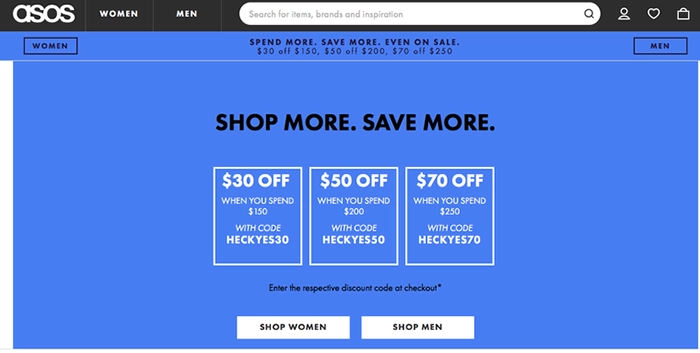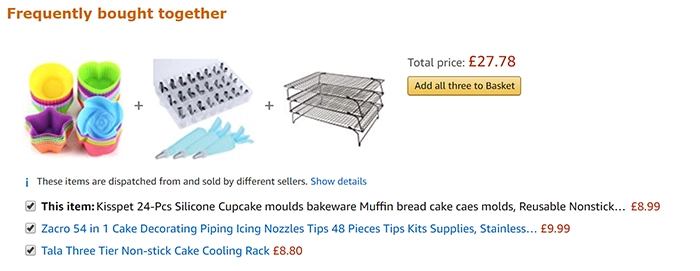How To Increase The Average Order Value (AOV) Of Your eCommerce Store
The Average Order Value of a purchase, or AOV as it’s sometimes known, is a key indicator of performance for any business, particularly those in eCommerce who thrive when AOV is high.
With Average Order Value specifically measuring the average transaction amount, an understanding of your own AOV can help you better understand your customer base and identify opportunities to optimize your marketing efforts and pricing strategy.
In fact, by increasing your AOV you stand to make more profit, which can be used to not only fuel your marketing campaigns, but also invested back into product development.
So, how do you calculate your average order value? And more importantly, how do you increase it?
Below, we’ve included a simple formula that will allow you to work out your website’s average order value for any given time period, along with seven tips on how to increase this number going forward.
How to calculate Average Order Value.
So, how do you work out the average order value of your online store?
In short, by dividing the total revenue by the number of orders on your site.
Revenue ÷ Number of Orders =Average Order Value
Now the first thing to note here is that you will need to determine a time frame for your average order value.
Take January 2019, for example.
Let’s assume your website sales for this period was £56,400 and you had a total of 1,500 orders.
£56,400 ÷ 1,500=£37.60
Using this AOV calculation, your average order value for January 2019 would be £37.60.
Tips for increasing Average Order Value (AOV).
Now that you know the AOV of your online retail site, let’s look at the changes can you make to increase it and get more from your paying customers.
1. Introduce a free shipping threshold.
How many times have you loaded your shopping basket online, only to find that you’re a few pounds short of the free shipping threshold?
And how many of these times have you added something extra to your shopping cart just to qualify?
Probably a fair few.
Using consumer psychology to increase the transaction value is certainly a worthwhile strategy and including a free shipping threshold is a great place to start.
In fact, if you promote the free shipping threshold as soon as they reach your ecommerce site, just like fashion retailer SilkFred in the example below, they can browse with the threshold in mind and add more to their basket as they go along.

2. Bundle deals to increase sales.
Just like the free shipping threshold mentality, everyone wants to feel as though they are getting a good deal.
Which is why bundle deals work so well.
The most common form of bundle deal is a 3 for 2 on similar products, in which the price of the 3 products is less than it would be when purchased individually.
With bundles, it needs to be obvious to the customer that they are getting a good deal for it to tempt them. For this reason, 10% or more discount is advisable.
It’s also worth bearing in mind that these kinds of deals work best on the most popular products that people need.
Take Topman’s Basic T-Shirts offer, for example, which are priced at £7 each or two for £12.
Although not a huge discount, it still works because they are a basic essential, and shoppers are likely to buy more than one if there is a saving (even if it’s only a couple of pounds).
Alternatively, there’s the approach of saving money on multiple purchases.
In fact, Topman nail this with their ‘Buy 2 Pairs of Jeans, Save £15’ deal.

This isn’t the only type of bundle deal to consider though.
In fact, it can prove particularly lucrative to offer pre-packaged product bundles, particularly around retail holidays such as Black Friday and Christmas, as these make great gifts.
3. Time sensitive deals.
For a great example of time sensitive deals, look no further than Pretty Little Thing.
As soon as you land on their website you are exposed to a banner which indicates that there is a deal ending, with a countdown to the end time.

This crafty example of adding pressure gives the customer an ultimatum and encourages them to purchase quickly.
In fact, this is a clever tactic because when shoppers have time to make a decision, they are more likely to abandon their basket – something every ecommerce marketer hates.
Time sensitive deals also give the illusion of a great offer, whilst prompting the consumer to take action and increase their order value. The rationale being, “I will probably purchase these items at some point, but if I do it now, I will benefit from a time sensitive discount”.
4. Show targeted product recommendations.
The best way to up your AOV is by suggesting products that the consumer might be interested in purchasing.
This is usually done right at the end of the shop, or once they’ve added another item to their basket.
Showing targeted recommendations based on a customer’s previous purchase and search history will ensure that you target them with the products they are most likely to add to their basket at the last minute.
Often these products will be things that the customer might have wanted for a while but decided they don’t need right now.
Having these targeted recommendations crop up will help to persuade the customer to increase their order value.
5. Minimum spend discount.
A minimum spends discount is a great way to tempt the customer into spending more, whilst giving them the impression that they’re getting a good deal – in a similar way to the free shipping threshold.
In fact, a great way to introduce minimum spend discounts is right at the start of their online shopping experience, whether that be on your shomepage, or as a popup if they land on a particular product page.
Ideally, you want to be making it clear that they will be eligible for a discount after a certain amount is spent.
This could be either a percentage-based discount or a monetary discount, similar to ASOS’ regular spend and save offers.

6. Use cross-selling techniques.
Cross-selling techniques can receive bad press for being pushy tactics, when in actual fact they can be really useful for customers looking to pair items.
After all, cross-selling works by suggesting additional items that complement the item a user has placed in their basket, something Amazon does particularly well.
Let’s say you’re on the marketplace to buy some cupcake moulds.

As you can see from the above example, Amazon will automatically suggest that you add a cake decorating set and a cake cooling tack, by using the ‘customers who bought x also bought y’ technique.
Ultimately, this is an effective way to increase your average order size, while being helpful and authentic amongst potential customers.
7. Offer live chat.
A major reason that a customer might abandon their basket or avoid adding an item to their online shop in the first place, is because they have reservations about the product.
In many cases, they may have specific questions about the product that need addressing.
While we would recommend that you provide as much detailed information as possible in your product descriptions, it can also be beneficial to offer live chat, so that prospective customers can ask necessary questions and receive responses in real-time.
By keeping them engaged, you not only deter them from abandoning their shopping cart, but you can also make product recommendations that can up the average order value.
So, there you have it,
The best ways to increase your site’s average order value are relatively simple, yet can make a huge difference to the profitability of your business.
It’s also important to keep in mind that while Average Order Value is a valuable metric, it’s not the only one to consider. In fact, as an online seller you should be monitoring your best and worst performing sales channels, inventory turnover and stock demand, amongst other ecommerce metrics, in order to make strategic and profitable business decisions.